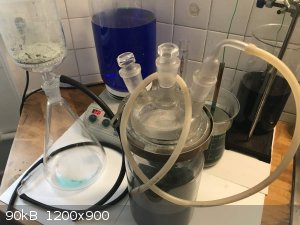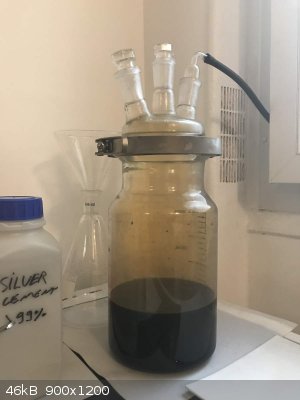Junk_Enginerd
Hazard to Others
  
Posts: 250
Registered: 26-5-2019
Location: Sweden
Member Is Offline
|
|
Oily layer in HNO3 distilled from bisulphate and nitrate?
I've distilled a few hundred ml of red fuming nitric acid from sodium bisulphate and sodium nitrate. Went well and product seems good, except there's
some form of immiscible oil in there as well. I'd estimate it to one or two percent of the total volume, floating around exactly like oil on water.
What might this oil be? Is it normal? The only contamination source I can imagine would be tape and hoses of silicone and pvc. Would that have
contributed?
|
|
|
Draeger
Hazard to Others
  
Posts: 185
Registered: 31-1-2020
Location: North-Rhine Westfalia, Germany
Member Is Offline
Mood: Slowly getting ready for new projects
|
|
I've heard HNO3 liquifies silicone rubber, so it might be that.
Collected elements:
Al, Cu, Ga, C (coal), S, Zn, Na
Collected compounds:
Inorganic:
NaOH; NaHCO3; MnCl2; MnCO3; CuSO4; FeSO4; aq. 30-33% HCl; aq. NaClO; aq. 9,5% ammonia; aq. 94-96% H2SO4; aq. 3% H2O2
Organic:
citric acid, sodium acetate, sodium citrate, petroleum, mineral oil
|
|
|
Herr Haber
International Hazard
    
Posts: 1236
Registered: 29-1-2016
Member Is Offline
Mood: No Mood
|
|
Have you seen any degradation in your tubing ?
Can you try to pipette it out ? You could redistill but the losses...
Anyway, be careful storing that RFNA if you leave whatever it is in there.
Edit: Degradation such as yellowing or stiffening.
[Edited on 24-7-2020 by Herr Haber]
The spirit of adventure was upon me. Having nitric acid and copper, I had only to learn what the words 'act upon' meant. - Ira Remsen
|
|
|
Junk_Enginerd
Hazard to Others
  
Posts: 250
Registered: 26-5-2019
Location: Sweden
Member Is Offline
|
|
rquote=641315&tid=155856&author=Draeger]I've heard HNO3 liquifies silicone rubber, so it might be that.[/rquote]
Really? That's annoying. I knew silicone wasn't going to be resistant to nitric acid, but I didn't think it would do something like that.
Quote: Originally posted by Herr Haber  | Have you seen any degradation in your tubing ?
Can you try to pipette it out ? You could redistill but the losses...
Anyway, be careful storing that RFNA if you leave whatever it is in there.
Edit: Degradation such as yellowing or stiffening.
[Edited on 24-7-2020 by Herr Haber] |
Haha, oh yeah. Those tubes are definitely single use. The smooth, transparent and supple silicone hose becomes an opaque and stiff mess after a while.
That goes for the PVC parts as well.
Sure. It coalesces into a nice coherent floating puddle that I could probably catch quite easily. Just wasn't sure if I might have missed something
and that it might have been normal.
|
|
|
Herr Haber
International Hazard
    
Posts: 1236
Registered: 29-1-2016
Member Is Offline
Mood: No Mood
|
|
Where do these tubes go in your distillation setup so they contaminate the product ?
I mean... I can see pvc on a vacuum pump inlet and silicone on the outlet. Both would get shredded in a single run but wouldnt contaminate your acid.
Viton is my favourite choice to connect to gas outlets, washing bottles and such. Sometimes silicone is still useful (and cheap), so is PVC. You'll
appreciate not having to take special care removing rotting tubing and cleaning the connections of your glassware
The spirit of adventure was upon me. Having nitric acid and copper, I had only to learn what the words 'act upon' meant. - Ira Remsen
|
|
|
outer_limits
Hazard to Others
  
Posts: 139
Registered: 3-3-2020
Member Is Offline
Mood: hybridized
|
|
If your entire apparatus was made of glass with ground glass joint I would say that it could be grease - if you used grease.
Using sulphuric acid is better idea because nitric acid is strong oxidizer and grease doesn't have a chance.
Tubing degradation products couldn't contaminate the product if they were used outside apparatus.
But you mentioned that you used a tape, it could be the source of contamination.
If I were you I would clean the product.
[Edited on 24-7-2020 by outer_limits]
|
|
|
Syn the Sizer
National Hazard
   
Posts: 591
Registered: 12-11-2019
Location: Canada
Member Is Offline
|
|
Yes your best bet with distilling nitric acid is no thermometer unless you have a viton seal. Otherwise just stick a stopper in the top of the
stillhead. Use sulfuric acid to seal the joints and if feeding gas to a secondary vessel to make dilute acid use a good resistant tubing, PTFE tubing
works but is very rigid and due to its non-stick properties really doesn't want to stay on the gas outlet.
Nitric acid will eat everything. You should store it in a resistant bottle with a PTFE sealed lid or glass stoppered bottle.
I know a lab in the city that gets tons of stuff in PTFE bottles, different sizes, they transfer out of the bottles into their storage and chuck the
bottles. One of the employees told me to ask if I could have some when the lab starts running again.
|
|
|
Junk_Enginerd
Hazard to Others
  
Posts: 250
Registered: 26-5-2019
Location: Sweden
Member Is Offline
|
|
Quote: Originally posted by Herr Haber  | Where do these tubes go in your distillation setup so they contaminate the product ?
I mean... I can see pvc on a vacuum pump inlet and silicone on the outlet. Both would get shredded in a single run but wouldnt contaminate your acid.
Viton is my favourite choice to connect to gas outlets, washing bottles and such. Sometimes silicone is still useful (and cheap), so is PVC. You'll
appreciate not having to take special care removing rotting tubing and cleaning the connections of your glassware |
The tubes connect the reactor to the condenser, and as such will take the full force of boiling HNO3, hot NO2 and O2.
Quote: Originally posted by outer_limits  | If your entire apparatus was made of glass with ground glass joint I would say that it could be grease - if you used grease.
Using sulphuric acid is better idea because nitric acid is strong oxidizer and grease doesn't have a chance.
Tubing degradation products couldn't contaminate the product if they were used outside apparatus.
But you mentioned that you used a tape, it could be the source of contamination.
If I were you I would clean the product.
[Edited on 24-7-2020 by outer_limits] |
No grease. Also no glass joints, silicone/pvc tubing with PTFE stoppers.
Indeed sulfuric acid is better, as is buying RFNA right off the shelf, but sodium bisulfate is the closest I'll get...
Quote: Originally posted by Syn the Sizer  | Yes your best bet with distilling nitric acid is no thermometer unless you have a viton seal. Otherwise just stick a stopper in the top of the
stillhead. Use sulfuric acid to seal the joints and if feeding gas to a secondary vessel to make dilute acid use a good resistant tubing, PTFE tubing
works but is very rigid and due to its non-stick properties really doesn't want to stay on the gas outlet.
Nitric acid will eat everything. You should store it in a resistant bottle with a PTFE sealed lid or glass stoppered bottle.
I know a lab in the city that gets tons of stuff in PTFE bottles, different sizes, they transfer out of the bottles into their storage and chuck the
bottles. One of the employees told me to ask if I could have some when the lab starts running again. |
I do have some PTFE tubing, but it is the kind used for 3d printers and as such the inner diameter is <2 mm, which ends up creating complicating
pressure levels that are tough to seal. That's why I gave silicone and PVC tubing a go, aware that they would probably be single use.
It does indeed have a healthy appetite... It's sitting in a glass bottle.
|
|
|
Syn the Sizer
National Hazard
   
Posts: 591
Registered: 12-11-2019
Location: Canada
Member Is Offline
|
|
I think this is where the oily layer is coming from, you need glass to distill HNO3
Bisulfate works fine for the synthesis, it is cheap and easy to find. But to seal the glass joints sulfuric acid works best since it has a high
boiling temp.
|
|
|
Herr Haber
International Hazard
    
Posts: 1236
Registered: 29-1-2016
Member Is Offline
Mood: No Mood
|
|
Reactor and tubing you say 
I empty the reactor by applying pressure on one of the inlets. The silicone tubing doesnt like the leftover acid (excess silver then left around 80°
c until bubbling disappears so days)
On the funnel is thick Viton. Around the flask and in the second picture is another thinner Viton tube that I leave connected to the glass.
I use it for NOx, chlorine, dipping in NaOH etc.
It doesnt show any sign of aging.
Teflon is too rigid for tubes unless you plan to install them semi permanently somewhere. But I love teflon. See all the white squares ? 
 
The spirit of adventure was upon me. Having nitric acid and copper, I had only to learn what the words 'act upon' meant. - Ira Remsen
|
|
|
Syn the Sizer
National Hazard
   
Posts: 591
Registered: 12-11-2019
Location: Canada
Member Is Offline
|
|
I was curious if you could get viton tubing, I was googling and all I could really find was seals. I agree PTFE tubing is worse than copper for
moldability. Copper once bent stays in position, even with heating PTFE doesn't really hold form. I was curious if they made PTFE springs. I feel with
how rigid and form.holding PTFE is it could make a decent low force chemically resistant spring.
Is the tube reasonably priced?
|
|
|
Herr Haber
International Hazard
    
Posts: 1236
Registered: 29-1-2016
Member Is Offline
Mood: No Mood
|
|
10/12 mm is 26.10E per meter from one of my expensive sources.
It's about the same price as PTFE and looking back it's a very good investment.
The spirit of adventure was upon me. Having nitric acid and copper, I had only to learn what the words 'act upon' meant. - Ira Remsen
|
|
|